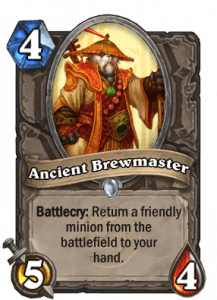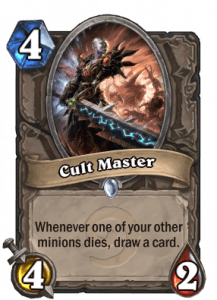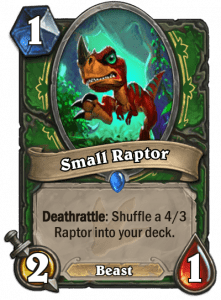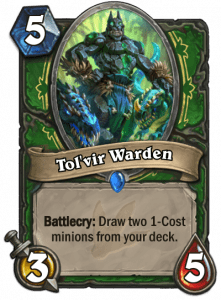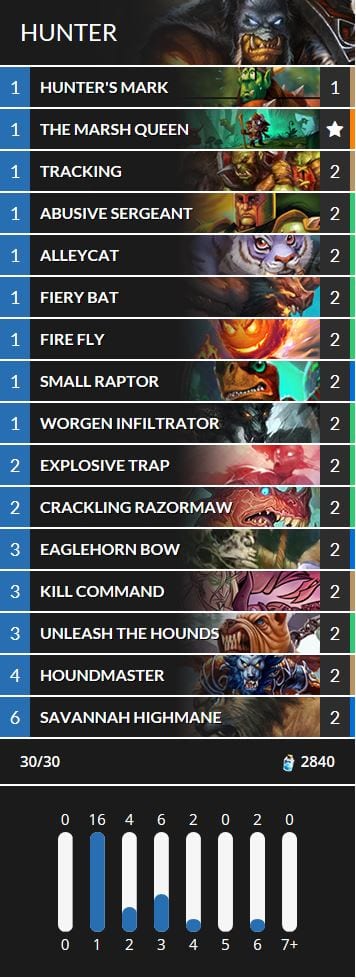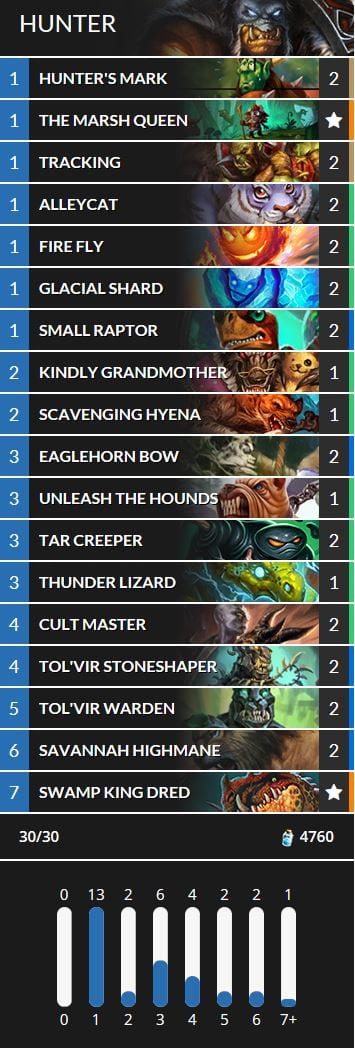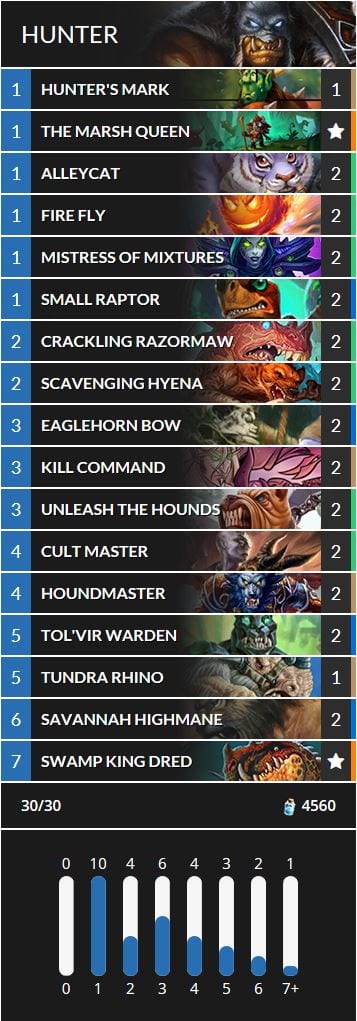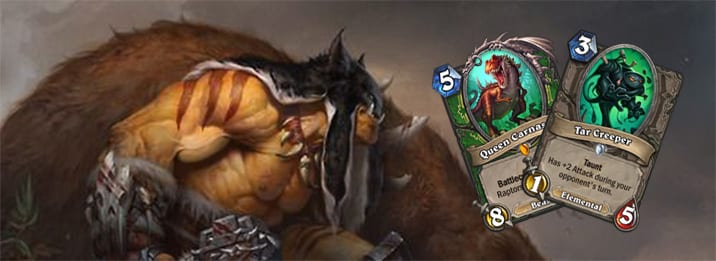
Brood War – Elemental Swarm & Beast Swarm (Theorycrafting: Standard – Mammoth)
by OtakuMZ - 7 years ago show comments
Introduction
The new Hunter quest ‘The Marsh Queen’ is very intriguing. Its flavor of swarming your opponent with a raptor army is so well designed I just want to play it. The question that bothers me though is how many one-drops I have to put in the deck to make the quest consistently trigger.
Edit: This article was intended to just highlight a Elemental focused deck but as there were new Hunter Beast cards revealed over the course of the weekend, a Beast Swarm deck makes even more sense. Nevertheless, I will not bury my initial idea of a control focused Elemental Swarm deck because I still have hopes it might be a thing.
Building a Swarm Deck
Ville “Old_GuardianHS” Kilkku posted an excellent analytical article regarding the problem of finishing the quest in the Hunter swarm decks: Journey to Un’Goro: An early look at Swarm Hunter. He also released a video accompanying the article. I will take some slightly altered examples out of his article to explain why I think my approach could be viable in the meta.
Note: the math Ville used is not exact but more of a apporximation. If anyone has a more accurate model to calculate probabilities I would be glad to hear about it.
Approach 1: Full Weeny: The simplest approach would be to put 29 1-drops plus the quest in your deck.
Approach 2: As Low As Possible: If we run 12 1-drops, 2 of which are Fire Fly which counts double because they generate a 1-man token to your hand. In this case, we will have the quest finished by turn 7 with a 12% chance and by turn 10 with a 47% chance.
Approach 3: Middle Ground: If we stack up to 16 1-drops in the deck by adding another four low-cost cards, the probability of finishing the quest by turn 7 will raise to 46% and by turn 10 to 87% respectively.
Conclusions
Approach 1, though the simplest one, is not the way to go because finishing the quest it would leave you very draw dependent with an above 50% chance to just draw a 1-drop in the later stages of the game. The dream of flooding the board with one Carnassa’s Brood after another would be very hard to accomplish this way, and you would not have the power to overwhelm your opponent fast enough.
Approach 2 gives us a low chance to finish the quest soon enough for making it the core strategy of your deck. If you use a low number of 1-drops, it implies that you go for the long control game. In this case, you would look for stall cards in this mana slot like Mistress of Mixtures and the new Glacial Shard which freezes an enemy.
Approach 3 might be the most reasonable way to go even though the high 1-drop count does not look particularly pleasant.
Cheating 1-Drops
We already have a way implemented in the above examples to cheat in the 1-drop department through Fire Fly which gives us another 1-drop to our hand. As it turns out, Hunters have some tricks up their sleeves to cheat even more.
Neutral Cards
Typically, we would use card draw to get more cards to our hands, but this is a mechanic in which Hunter struggles since the nerf of Starving Buzzard. Sadly, apart from Fire Fly, there is no other 1-drop that gives us more cards. Other options are the usual suspects: Loot Hoarder, Bloodmage Thalnos, Novice Engineer, Gnomish Inventor, The Curator. All of those do not synergize well with Hunter decks unless you go the N’Zoth route. A more appropriate card might be Cult Master, which lets us trade our weeny minions to get additional cards. More recently, it was put to good use in Jade Rogue, which follows a similar plan of flooding the board early and trading away the board advantage in bigger minions to get more late game Jade stuff to transition to the late-game. We could even think about pairing it with Unleash the Hounds for some cycle action starting turn 7.
Another mechanic to virtually increase the number of 1-drops is by bouncing them back to your hand and playing them again. There are two cards outside of Rogue available that will enable you to do that: Youthful Brewmaster and Ancient Brewmaster. Though not impactful enough on stats, the inclusion of one Brewmaster may be considered as it can double up to bounce back either a heavily damaged big bomb like Swamp King Dread or even Queen Carnassa for
Hunter Class Cards
Atop, there is the newly introduced Tol’vir Warden, which gives you two 1-mana minions to your hand AND thinning out your deck to get to the big stuff. He might not be useful in very aggressive strategies though. Last but not least, Tracking might come in handy as well. In the case of missing a 1-drop, you can easily manage to get one off it. In the case you are already about to finish your quest, a secondary effect might be filtering out unwanted weeny minions and drawing late-game threats like Savannah Highmane, Call of the Wild or N’Zoth.
To conclude, by using some non-1-drop cards, that make your gameplan more reliable. You can virtually ramp up your weeny count significantly and achieve the goal of completing the quest safer around turn 7-10. I expect that there is at least one more card being released that synergize with The Marsh Queen. As I was proof reading this article, the expected card got released: Small Raptor, a 1-mana 2/1. This sounds unimpressive, but as a Deathrattle, this dino shuffles a 1-man 4/3 (!) Raptor to your deck. This token is perfect to be drawn by Tol’vir Warden later on. Both, Small Raptor itself as well as its token, are Beasts. With those two, there is enough preemptive Beast synergy again available that I decided to amend a Non-Elemental Swarm list in the section below which I call “Beast Swarm”.
Elementals
Yes, you heard right, Elementals! All of the new 1-mana neutral minions so far are Elementals.
Fire Fly will be a natural inclusion to the deck and because of it adding another 1-drop t Glacial Shard is a good fit in the more midrange to control oriented theme. Tar Creeper into Tol’vir Stoneshaper could be good enough for some early- to mid-game protection. The high amount of Elementals in the deck (6+2 tokens) should guarantee a consistently enabled.
Mistress of Mixtures helps to stay alive until the quest is finished. The rest of the cards are standard midrange Hunter cards like Eaglehorn Bow, Unleash the Hounds. I theorycrafted two lists, which you can see below. One is featuring removal in the form of Kill Command which might be a little too inconsistent with only six Beasts in the deck. The other sticks more to the Weeny and Bombs theme, featuring Swamp King Dread and Call of the Wild alongside Cultmaster and one Deadly Shot replacing Two Argent Squires and the Kill Commands. The topping is one Youthful Brewmaster – which could easily be replaced – but wouldn’t it be amazing to shuffle 30 Carnmassa’s Brood in the deck? It also could bounce a Fire Fly or other one drop to get the quest going.
Update: Thunder Lizard was just released which is a hybrid Beast / Elemental card. This encourages my Elemental swarm idea!
Beasts
Beast synergy in Hunter is nothing new. It has been a thing since the beginning of Hearthstone when nobody was even thinking about Druid or other classes when looking at the Beast tag. I will not list each and every Beast or beast synergy card that is available, but only the choices I made for the theorycrafted decks and important cards that could be used to replace lesser important cards for the core concept of the deck.
Small Raptor is an auto-include because it can cheat another 1-drop in your deck without using up additional deck slots.
Fiery Bat. A good early game minion more prominent in aggressive decks.
Houndmaster is the protection we need to follow a more middle- to late-game oriented playstyle. It offers a total of 6/5 for five mana which is very good with the downside of requiring a Beast an board. The latter should not be too difficult with the deck proposed.
Crackling Razormaw looks powerful with so many small Beasts. Also giving Divine Shield or Taunt a bigger beast seems exceptional. In any case, I evaluate it superior to Trogg Beastrager because it is more flexible, has immediate impact on the board and belongs to the Beast tribe itself.
Scavenging Hyena is perfect in this deck. It can be either used to trade in cheap Beasts in order to grow or optimally during the onslought of omultiple Carnassa’s Broods. On turn 10, paired with a few of the Broods and Tundra Rhino it could grow to a 8/5 with Charge. If you were lucky enough to have a Tundra Rhino sticking around on board, it could even get to a maximum of 18/10 charge minion. Just to dampen the outcry a little, you would have to be lucky enough to draw into one Brood after another.
Tundra Rhino is a charge enaler in the middle – to late-game that could lead to massive damage. It functions as a swing turn enabler or as a massive finisher. It is debatable to include one or two copies.
Alley Cat. Sadly the token from this 1-drop is summoned rather than played. Anyway, it provides decent board presence in the early game to contest more aggressive decks and brings the Beast tag on both minions, the one played and the token.
Kill Command – a classic. Threee damage for three mana is one mana to expensive, but five damage is great. The ‘Beast on board’ pre-requisite is adownside but we have enough beast to consistently activate the bonus damage. Kill Command is also a flexible card as it can either be used as removal or to finish off an opponent with face damage.
Kindly Grandmother (flex card) may be important to include to further contest aggressive decks and have something to trade for the Hyena. It has to be seen if this Beast is necessary or not.
Non-Elemental/Non-Beast 1-Drops to Consider
Arcane Anomaly will be converted into an Elemental with the Year of the Mammoth. In a more spell oriented version of the deck, it could be an inclusion. The card performed weakly regarding its effect since it was released, but the Elemental tag could seal the deal for it.
Argent Squire is one of the most versatile early game minions. It allows for good trades in conjunction with Abusive Sergeant or can trade into two small minions when facing aggressive decks.
Abusive Sergeant could be included if you follow a more aggressive midrange strategy, helping to make value trades or cheat in some additional damage. Stonetusk Boar and Worgen Infiltrator are other aggressive cards that might fit in.
Bloodsail Corsair, Southsea Deckhand, and Patches the Pirate might also be considered in an aggressive version IF there is a cheap Hunter weapon available and/or if weapon classes are still dominant on the ladder. In the latter case, a tech Gluttonous Ooze might be the superior way to construct the deck. Keep in mind, though, that Patches, when summoned by another Pirate, does not count towards the quest goal.
Leper Gnome, though post-nerf not so prominent anymore, is still a cheap option for aggressive archetypes.
Mistress of Mixtures is strictly tied to a late-game oriented game-plan.
Secretkeeper is also worth considering but running lots of Secrets alongside a high number of 1-mana minion will most likely result in a hand that is dumped early. That would leave you without nothing to do. This problem is emphasized when paired with Cloaked Huntress and due to the lack of card draw in Hunter.
The Lists
I played around with a few different lists. Finally, Elemental Swarm which emphasizes the Elemental Synergy that might arise from the 1-man Elementals results in a slower game-plan due to the Taunts. Beast Swarm that abuses the good Hunter Beast synergy with cards like Houndmaster, Scavenging Hyena and the new Crackling Razormaw can either be played aggressively or slower. Looking at the history of Hunter, it is more likely that the more aggressive Swarm deck will dominate, because aggressive strategies play more in line with the Hunter hero power. Nevertheless, I made the (late-)midrange lists as Midrange Hunter was the more consistent archetype overall in Hunter and to be honest, I feel more comfortable playing this kind of deck. This will most likely resul in me aggressive lists being a lot worse than the midrange one. In any case, the list can only be viewed as a starting point for playtesting, please keep that in mind.
The different versions have the their respective potential number of 1-drops listed below each deck. In this, all generated tokens and draws from Tol’vir are accounted for. Draws from Cult Master are not included in this equation. This number of 1-drops needed is still unclear and cannot be reliably figured out without playtesting. The needed number also depends heavily on your overall game-plan. If you are going the aggressive route, a higher number will be needed and/or more card draw has to be included in the list to secure getting the quest done early enough. If you plan for a more mid- to late-game, a lower number of weenies are enough and leaves space for removal and stabilizing tools.
If the quest delivers consistently, maybe there is room to replace a weakly performing 1-mana minions with a bit more removal or burst damage. Maybe there is even a good early-game weapon to be found in Un’Goro. A decent weapon would be helpful because of my gut feeling telling me, without being able to playtest the deck, that both lists might need a bit more removal.
- Beast Swarm (1-drops: 18, Aggro)
- Elemental Swarm (1-drops: 18, Midrange)
- Beast Swarm (1-drops: 16, Midrange)
Note: by the time this article went live, the deck builders did not have Small Raptor implemented. Therefore, I used Webspinner in its plce. I will replace the images once an update on the builder is available.



